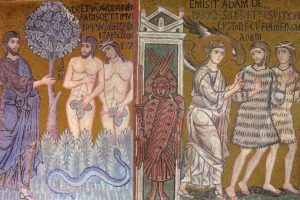
The fourth and final Sunday of the pre-Lenten cycle is Forgiveness Sunday.
Click here for the text of Vespers, Orthros, and the Divine Liturgy variables.
Click here for the Typica service. (When reading Typica instead of attending Liturgy, you will need both the Typica and Divine Liturgy texts.)
Theme
The primary theme is forgiveness of each other of sins and offenses, and personal renewal with mankind (with each other), so as to prepare for the personal renewal with God during Great Lent. A sub-theme is Adam’s exile from paradise. We are to identify ourselves with Adam, lamenting our loss of the beauty, dignity and delight of our original creation, mourning our corruption in sin.
Observance of the Week
Also known as Cheesefare, this Sunday is the final day of eggs and dairy-eating until Pascha. (This is the rule, though observance can vary based on age, health concerns, and other factors. Such things are sorted out between the individual and their priest.)
Sunday evening, Orthodox Christians attend a special service called Forgiveness Vespers, where all present ask and receive forgiveness of each other in turn.
The Monday immediately following Cheesefare/Forgiveness Sunday is the first day of Orthodox Lent. This first week of Lent is known as Clean Week.
Biblical Story
The Sunday of Forgiveness has two themes: it commemorates Adam’s expulsion from Paradise, and it accentuates our need for forgiveness. There are obvious reasons why these two things should be brought to our attention as we stand on the threshold of Great Lent. Lent is a time when we weep with Adam and Eve before the closed gate of Eden, repenting with them for the sins that have deprived us of our free communion with God. But Lent is also a time when we are preparing to celebrate the saving event of Christ’s death and rising, which has reopened Paradise to us once more (Luke 23:43). So sorrow for our exile in sin is tempered by hope of our re-entry into Paradise.
The second theme, that of forgiveness, is emphasized in the Gospel reading for this Sunday (Matthew 6:14-21) and in the special ceremony of mutual forgiveness at the end of the Vespers on Sunday evening. Before we enter the Lenten fast, we are reminded that there can be no true fast, no genuine repentance, no reconciliation with God, unless we are at the same time reconciled with one another. A fast without mutual love is the fast of demons. We do not travel the road of Lent as isolated individuals but as members of a family. Our asceticism and fasting should not separate us from others, but should link us to them with ever-stronger bonds.
The Sunday of Forgiveness also directs us to see that Great Lent is a journey of liberation from our enslavement to sin. The Gospel lesson sets the conditions for this liberation. The first one is fasting—the refusal to accept the desires and urges of our fallen nature as normal, the effort to free ourselves from the dictatorship of the flesh and matter over the spirit. To be effective, however, our fast must not be hypocritical, a “showing off.” We must “appear not unto men to fast but to our Father who is in secret” (vv. 16-18).
The second condition is forgiveness—“If you forgive men their trespasses, your Heavenly Father will also forgive you” (vv. 14-15). The triumph of sin, the main sign of its rule over the world, is division, opposition, separation, hatred. Therefore, the first break through this fortress of sin is forgiveness—the return to unity, solidarity, love. To forgive is to put between me and my “enemy” the radiant forgiveness of God Himself. To forgive is to reject the hopeless “dead-ends” of human relations and to refer them to Christ. Forgiveness is truly a “breakthrough” of the Kingdom into this sinful and fallen world.
The Icon
The icon shows Adam and Eve standing before Jesus Christ. Prior to their descent into sin through disobedience, Adam and Eve were blessed with a beautiful relationship of communion and fellowship with God. However, they were tempted by the devil appearing in the form of a serpent to disobey God and eat from the tree of the knowledge of good and evil (Genesis 2:15-17).
When they took of the fruit and sinned, they realized that they were naked. Further, when “they heard the sound of the Lord God walking in the garden”…they hid themselves “from the presence of the Lord” (3:8). The icon shows Adam and Eve attempting to cover themselves with fig leaves as they try to hide, and yet they stand ashamed before the Lord.
Because of their disobedience the Lord expelled them from the garden. The icon shows the Archangel of the Lord directing them out of Paradise, through the gate of Eden where God placed “the cherubim and a sword flaming and guarding the way to the tree of life” (3:23-24). Adam and Eve are dressed in the garments of skins made for them by God (3:20).